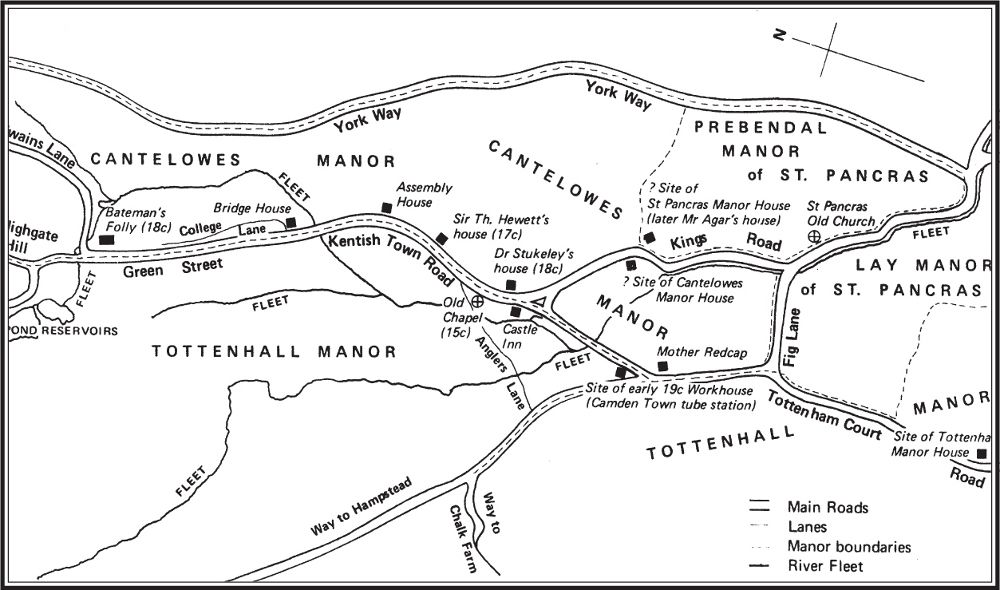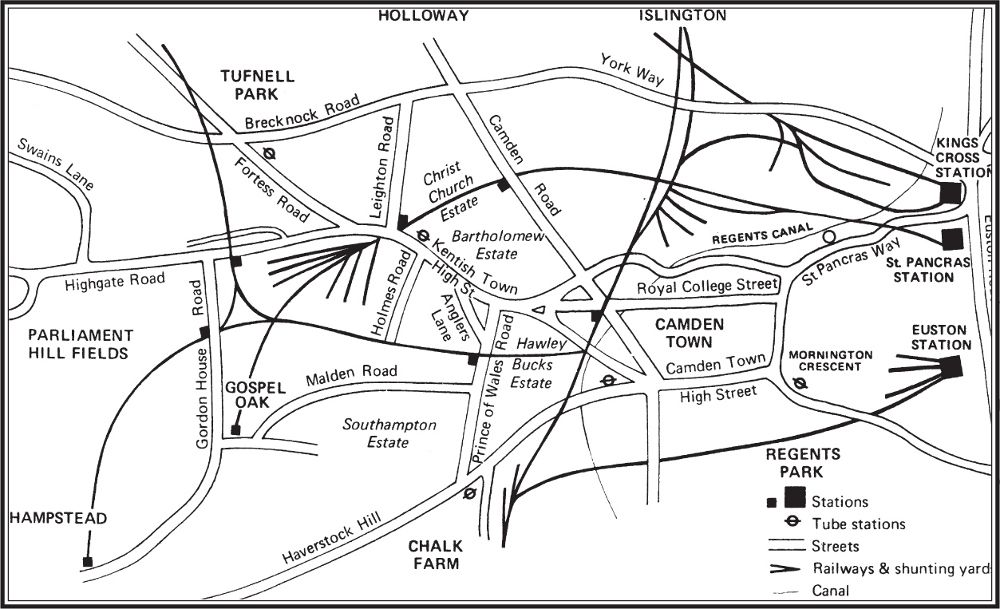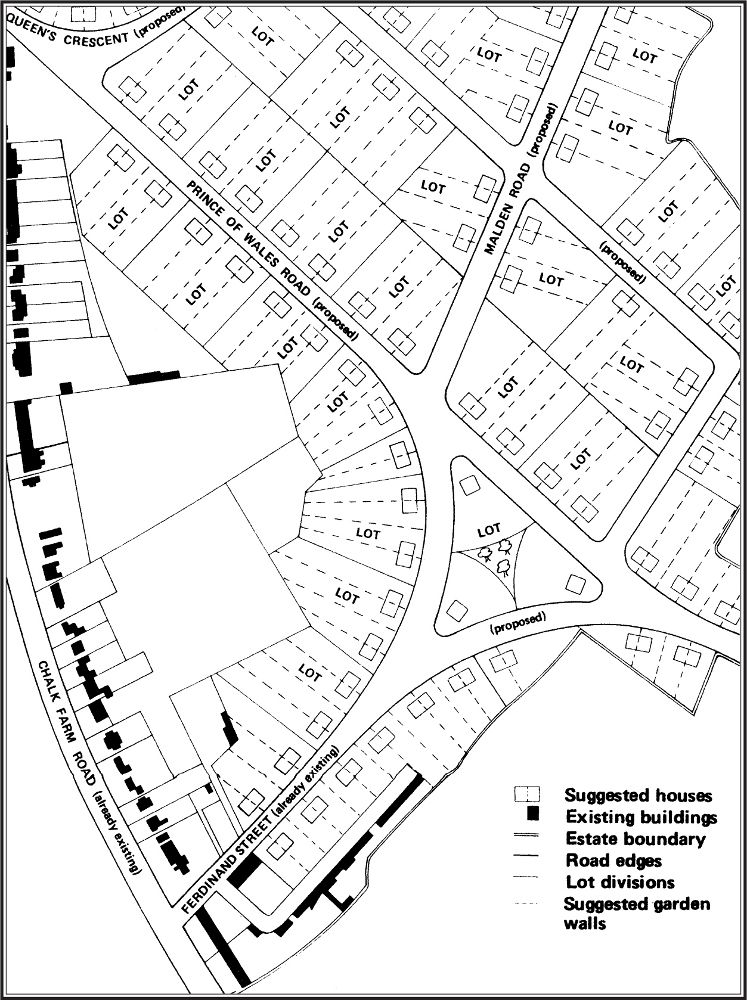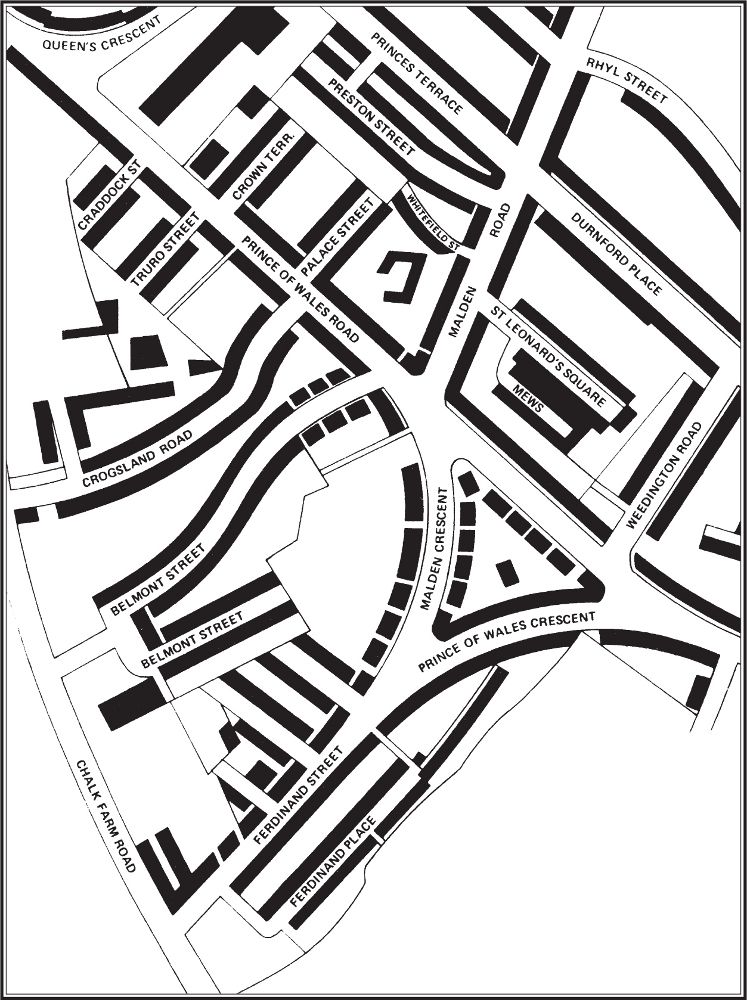The Fields Beneath
Read The Fields Beneath Online
Authors: Gillian Tindall

The history of one London village
GILLIAN TINDALL

… In succession
Houses rise and fall, crumble, are extended,
Are removed, destroyed, restored, or in their place
Is an open field, or a factory, or a by-pass.
Old stone to new building, old timber to new fires,
Old fires to ashes, and ashes to the earth
Which is already flesh, fur and faeces,
Bone of man and beast, cornstalk and leaf.
T. S. Eliot,
FOUR QUARTETS
‘Happy are those who see beauty in modest spots where others see nothing. Everything is beautiful, the whole secret lies in knowing how to interpret it.’
Camille Pissarro (1893)
This new edition of the book is dedicated to Mrs Bridget Tighe, born in County Sligo, Ireland in 1919, long time inhabitant of Kentish Town.
For all her unobtrusive help in my house over twenty-eight years, while I wrote this and many other books, I offer grateful thanks to her and to fate.

A: The growth of London

B: Pre-nineteenth century St Pancras parish

C: The same area by the early twentieth century

D: Part of the plans for the Southampton Estate, west Kentish Town (1840)
Each lot for sale was typically about 200 ft square and was envisaged as containing four houses arranged two by two, semi-detached.

E: The Reality: the same part of the Southampton Estate by 1880
A frontage of 200 ft now often holds a dozen houses, terraced, each with a narrow strip of back garden. Extra streets, especially cul de sacs, have been slotted into the holdings.

F: Further fantasy: plans for re-developing the same area, drawn up by the local authority in the early 1960s but happily never implemented.
It is almost thirty-five years now since the first edition of
The Fields Beneath
appeared. Other editions followed, but I was not able to update the work with anything more than a brief note. Not that ‘update’ is quite the word, for to keep a book of this kind accurate in each current detail – noting changes in shops, the enhancement or loss of buildings – would require constant, impractical revising and, at another level, would not be desirable anyway. Books of history do not go obviously out of date in the way that some other forms of writing tend to, but nevertheless a book is always a product of its own time, embodying the assumptions, hopes, fears and preoccupations of that time. This Postscript does not attempt to revise my earlier views, but it seems a good moment to take a general look at the way my chosen example of a village engulfed by a great city has continued to evolve over the past generation.
The overall theme of the book is, in any case, change. In the course of sixteen hundred years or so, Kentish Town was transformed from a small settlement beside a track some miles out of London into the busy inner-city district it is today. But this change, however momentous, was sporadic. For centuries nothing much happened, and at one point in the later middle ages the settlement even seems to have declined in size. A minor building boom in the sixteenth and seventeenth centuries produced the rural retreat within easy reach of town that was Kentish Town’s character throughout the eighteenth and early nineteenth century, though the wind of change began to blow more strongly after the end of the Napoleonic wars. The truly cataclysmic change came in the 1840s, ’50s and ’60s, when the pastures and market gardens that had been the backland to the High Road were covered inexorably, field after field, with terraces of houses. This was followed by the coming of a mainline railway, which bisected the district and destroyed, for the next hundred years, most of the pretensions it had had to prettiness and gentility. In the space of less than thirty years a sooty townscape was created, as if by a black-hearted fairy. These were essentially the streets that still make up NW5 today.
Because to us past eras are over, fixed and known, we tend to underestimate how traumatic such developments were to people living through them. In the mid-1970s I wrote: ‘To believe that change, and in particular the
speed
of change, is something peculiar to the twentieth century, is an error, at least where the physical environment is concerned. Except in a few specific places … the changes seen by many people living today are as nothing compared with the paroxysms of alteration and despoilation weathered by their great-grandparents.’ This, in 2011, should read ‘great-great-grandparents’, but it remains just as true.
It so happened that, when I was researching and writing
The Fields Beneath
, the lesser paroxysm of post-war redevelopment had only recently abated. I was thus able to describe this saga of misplaced idealism and Stalinist authoritarianism disguised as democracy while it was still very recent – see the book’s last chapter. But what is significant is that I have no comparable upheaval to report for the period between the late 1970s and today. Just as, by the 1870s, Kentish Town had acquired much the form and social composition that it was to have for the next eighty-odd years, so, after the intervening storm of the late- 1950s and ’60s, the place settled down again into very much the one that we still inhabit, more than thirty years on, and shows every sign of continuing for the time being in the same way.
In the 1970s some people feared that ‘by the year 2000’ (a then distant, mythic date) areas such as Kentish Town would have deteriorated into urban “jungles’ on the American model, dangerous to cross after dark and full of racial tensions, while others were optimistically convinced that the ever-rising price of property would ensure that Kentish Town in 2000 would be as affluent and exclusive as Chelsea. For more than one reason, I am pleased to report that neither of these predictions has turned out valid. The changes I have to signal are all relatively minor ones, in the scheme of things and in Kentish Town’s long and chequered history.
The trends visible in 1977 have simply become more evident. The district has remained remarkably mixed, socially, with inhabitants ranging from the obviously poor to the discreetly wealthy, and only the lower-middle class under-represented. You have to be relatively well-off, today, to buy a Victorian house in one of the area’s many pleasant, leafy side streets, and very few of these houses are still in multi-occupation: the old ladies who let lodgings have gone. However, the large amount of housing that remains in local authority hands continues to ensure that the district is hardly in danger of becoming exclusive. But one has to say, too, that the difference between one part of Kentish Town and another, often not far off geographically, has become more marked; and the foreboding that Kentish Town might become parcelled out, into expensively gentrified streets on the one hand and single-class ghetto estates of Council flats on the other, has to some extent come true. The planning-blight that descended upon west Kentish Town in the 1950s and ’60s had a permanent effect, and though the partial destruction and rebuilding in the name of ‘improvement’ in the years that followed was much less extreme than originally intended, it has confirmed west Kentish Town’s character as the less desirable side of town. Excepting, of course, places such Kelly Street and the Crimea enclave: these, once narrowly saved from demolition, are now carefully conserved, worlds away in character though not in distance from the ill-designed housing blocks and litter of Malden Road.
East Kentish Town has, by good luck, avoided such obvious ghettoisation. Here a whole grid-pattern of streets was initially bought by the local authority for demolition, but a belated change of heart meant the terrace houses were then rehabilitated as flats and maisonettes for Council tenants (see pages 231–2). These proved very popular, with the inevitable result that since the right-to-buy legislation of 1980, many of the properties have passed out of the Council’s stock of homes and into private ownership. They have often been sold on subsequently (something that the advocates of Council house sales apparently failed to envisage) and so the social mix is changing again, with the arrival in these streets of prosperous middle class youngsters starting out in life, or of older single people with some equity. Meanwhile, the Council has considerably fewer properties to offer to than it had thirty-five years ago. Also, the change in the allocation rules, from a system of points to the priority of need, has had the effect of excluding many solid citizens who would once have been offered Council accommodation. In Kentish Town, as all over London, this has meant that Council tenants, except for the entrenched elderly, tend to form an underclass without the profile of respectable ordinariness that they had in the recent past.
The most significant single change over the last generation has been Council’s embrace (at any rate in theory) of the idea that old buildings form a valuable heritage, and hence the designation of more and more sections as Conservation Areas where neither house-owners nor developers are free to alter windows, doors, roof-lines or back-additions at will, let alone demolish. The first CA, conservatively confined to a small collection of Georgian houses at the High Street end of Leighton Road plus the oldest part of the picturesque Leverton Street, was mapped out in 1985. That Area itself is now being widened to include the grid of small streets to the north and east, and some houses have been Listed. In the intervening years Torriano Cottages, most of the Christchurch and St Bartholomew estates, the Jeffreys Street-Rochester Square Area, Kelly Street, Harmood Street and the Crimea Area have been added to the canon, as well as the entire Dartmouth Park estate up Highgate Road.
The complete and admirable turn-about this represents, after the destructiveness of the preceding era, cannot be under-estimated, and I wish I could write that all anxieties about Kentish Town’s physical future could now be laid to rest. But it was in 1989, well after the principle of conservation was established, that the ancient Bridge House in Highgate Road was demolished over one weekend, because someone in the Planning Department had not checked their records (or this book). And at the time of writing, a protracted wrangle is still in process about the integrity of Little Green Street, a small cobbled way containing the area’s only surviving run of eighteenth century one-time shops. Inadvertently (or so it is said) Camden Council gave outline planning permission to a property developer planning to build a block of flats some way away down a pedestrian way (College Lane), not understanding that the developer was intending to turn Little Green Street into permanent vehicular access for all the future flat-owners and their projected underground garages. The impassioned row that has followed, in local and national press and elsewhere, may well be imagined by those who know what heat such issues these days arouse.
Sometimes, today, passions for the past can seem almost too enthusiastic. It is no longer the case, as it was in the 1970s, that the general public thinks that picturesque places like Hampstead have ‘history’ but that more ordinary and battered places like Kentish Town do not. Much more informed and detailed material has been published on various districts of Camden (see revised Sources) and interest remains great, though sometimes, as ever, a little fanciful. I became familiar with fantasies about remembered ‘farms’ when I was researching
The Fields Beneath
, but no one then tried to tell me, as they have recently, that Leverton Street was ‘originally built for a colony of expatriate Portuguese fishermen’. (Under what circumstances a Portuguese fisherman would come and settle in Kentish Town was not explored). The basis for this tale is, I think, that these one-time railways workers’ cottages, which long ago were painted in standard shades of peeling margarine, are now a rainbow of different colours, from palest green through subtle blues and greys, unashamed pink and virile terracotta – the influence, no doubt, of the holidays abroad taken by the new generation of owner-occupiers. But one may be extremely thankful that the same emotion of pride and love for the immediate environment that dreamed up the Portuguese fishermen also, in 2002, saved the Pineapple public house half way up the street from imminent disappearance. Neighbours enlisted every local celebrity to the cause and got the pub’s intact Victorian interior spot-listed by English Heritage. The place continues to thrive.
Many other pubs have closed in Kentish Town and Camden Town in the last decade. The writer who complained in
The Builder
in 1854 that there far too many of these edifices were being built might be gratified to know how few of these traditional meeting places remain, but of course this does not point to any decline in alcoholic intake, but simply to changing habits. Famous pubs such as the Castle, or the Old Farmhouse which were rebuilt in the mid-nineteenth century but retained their ancient names, are now many of them unrecognisable as restaurants, wine-bars or ‘music venues’. Others, especially in the side streets, have been converted into private flats. This was what a developer had hoped to do with the Pineapple, since such handsome buildings are often of more value now as real estate than in their designated usage. Others again have simply been swept away. The Assembly House survives, and now flourishes in responsible hands with much of its interior cut-glass intact, but it went through a bad patch in the 1990s, when the ornate window-glass that had lasted for almost a hundred years was either smashed or sold off by a series of dishonest tenant landlords. At the same period the commemorative marble table, which had been in the pub since the early eighteenth century (see pages 99–100), disappeared for good.
Relaxation in the licensing laws in recent years has brought late-night animation and frequently noise, fights, drunkenness and drug-trading to the heart of Camden Town. The huge and garish expansion of Camden Lock Market (now, unfortunately, ‘world famous’) has also had its effect. The determination of Kentish Town residents (backed, it should be said, by the local authority) has to date stopped Kentish Town from being degraded in the same way. An agreement seems to have been forged, among those who know the respective areas, that Camden Town is one place and Kentish Town is another, as historically they always have been, and any pushy bar-developer or his lawyer who think they will get the same licence in both places is in for a disappointment. Recently, the respective locations have been lettered into opposing sides of the wall of the railway viaduct across the road, which has long stood like a portcullis-gate where Camden Town might be said to end and Kentish Town to begin.
A visitor from the recent past would, I think, find much of Kentish Town rather cleaner than before, with less peeling paint, more elegant railings back in place, and fewer patched windows and rubbish-haunted front gardens, but the change is a matter of degree rather than a striking difference. The High Street is still choked with traffic morning and evening, but it flourishes, perhaps more than it did thirty years ago, with numerous walk-in supermarkets, green-grocery stalls, a long-established butcher-fishmonger, a smart halal alternative, an independent book-shop, a proper jewellers, a specialist needlework shop, a stationers, a baker’s, a hardware store resembling Alladin’s cave in its copious and varied stock, a large health-food store and several restaurants. (The one-time Daniel’s shop, later the site of Sainsburys, is currently a Somerfield store, with Sainsbury’s located further north, so any references to the position of the long ago Old Chapel should be adjusted to this).
By great good fortune rather than by any prescient plan, when a large section of the derelict one-time railway land was redeveloped it was for occupation by various light industries, a postal sorting office, a recycling centre and a car pound. None of these has impinged on the High Street’s continuing success as a traditional shopping centre, whereas a large supermarket with parking would have inflicted considerable damage. Unlike many other old urban centres Kentish Town has had a lucky escape. It is merely rather a pity that the lack of any coherent plan for the railway land has meant that an old right-of-way across it in the direction of Hampstead has never been restored, as, with informed planning, it might have been. The wide road built to service the various works now occupying ex-railway land leads, absurdly, to a choice of dead ends, in a wilderness of blocked-off railway arches, without even a much-needed footpath through these into west Kentish Town.